2019 HONDA CIVIC COUPE overheating
[x] Cancel search: overheatingPage 4 of 675
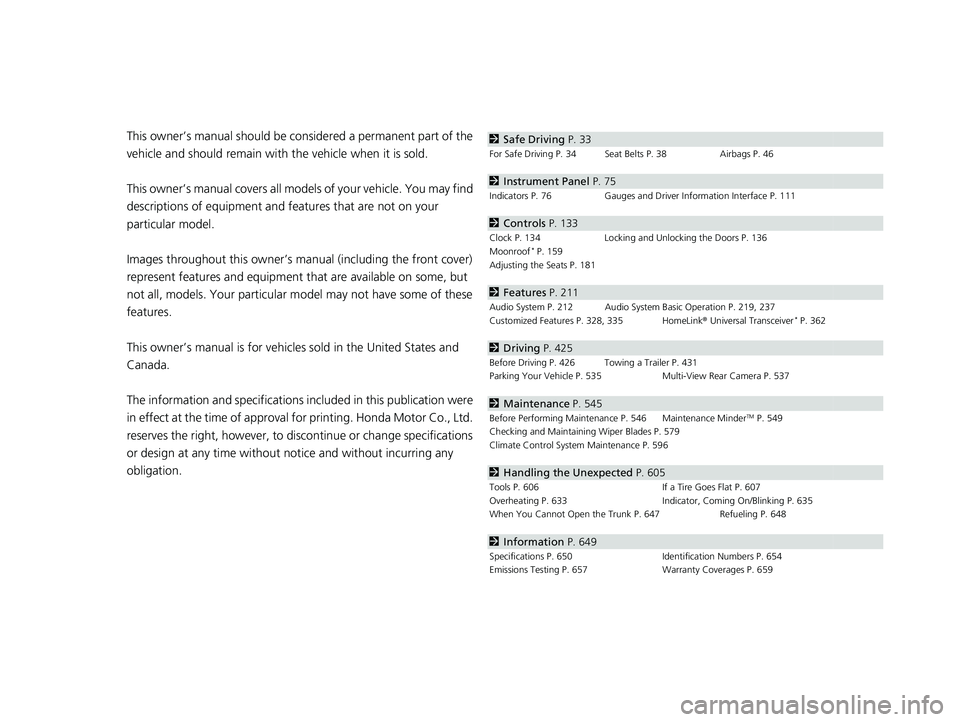
Contents
This owner’s manual should be considered a permanent part of the
vehicle and should remain with the vehicle when it is sold.
This owner’s manual covers all models of your vehicle. You may find
descriptions of equipment and features that are not on your
particular model.
Images throughout this owner’s manu al (including the front cover)
represent features and equipment that are available on some, but
not all, models. Your particular mo del may not have some of these
features.
This owner’s manual is for vehicles sold in the United States and
Canada.
The information and specifications in cluded in this publication were
in effect at the time of approval for printing. Honda Motor Co., Ltd.
reserves the right, however, to discontinue or change specifications
or design at any time without notice and without incurring any
obligation.2 Safe Driving P. 33
For Safe Driving P. 34 Seat Belts P. 38 Airbags P. 46
2Instrument Panel P. 75
Indicators P. 76 Gauges and Driver Information Interface P. 111
2Controls P. 133
Clock P. 134 Locking and Unlocking the Doors P. 136
Moonroof* P. 159
Adjusting the Seats P. 181
2 Features P. 211
Audio System P. 212 Audio System Basic Operation P. 219, 237
Customized Features P. 328, 335 HomeLink® Universal Transceiver* P. 362
2Driving P. 425
Before Driving P. 426 Towing a Trailer P. 431
Parking Your Vehicle P. 535 Multi-View Rear Camera P. 537
2Maintenance P. 545
Before Performing Maintenance P. 546 Maintenance MinderTM P. 549
Checking and Maintaining Wiper Blades P. 579
Climate Control System Maintenance P. 596
2Handling the Unexpected P. 605
Tools P. 606 If a Tire Goes Flat P. 607
Overheating P. 633 Indicator, Coming On/Blinking P. 635
When You Cannot Open the Trunk P. 647 Refueling P. 648
2Information P. 649
Specifications P. 650 Identification Numbers P. 654
Emissions Testing P. 657 Warranty Coverages P. 659
19 CIVIC 2D HCM (KA KL KC)-31TBG6300.book 2 ページ 2018年9月4日 火曜日 午後1時38分
Page 29 of 675
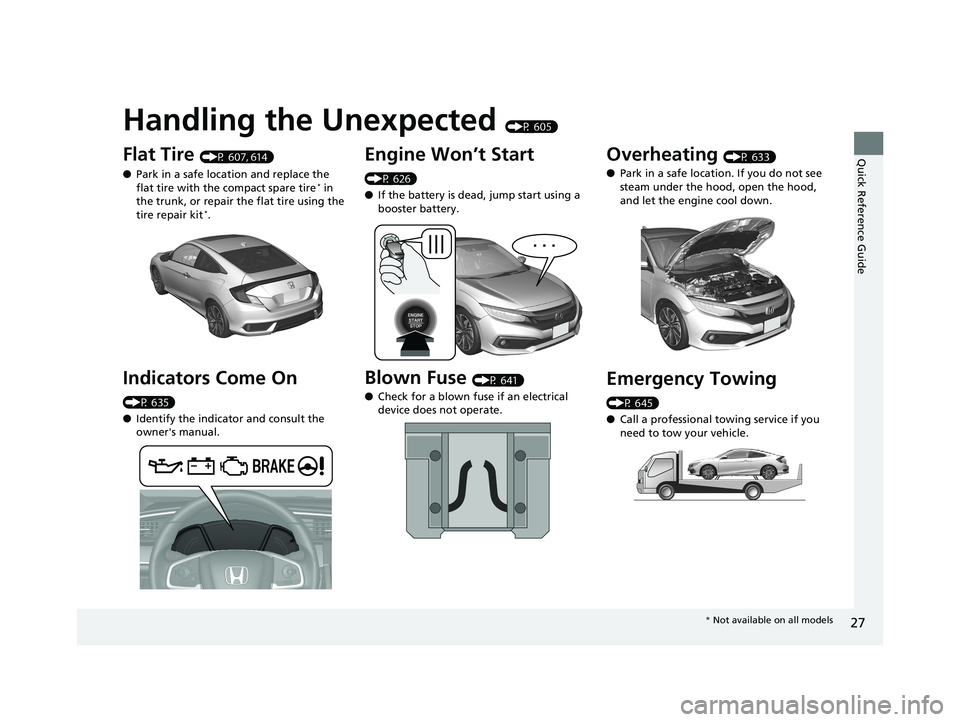
Quick Reference Guide
27
Handling the Unexpected (P 605)
Flat Tire (P 607, 614)
● Park in a safe location and replace the
flat tire with the compact spare tire
* in
the trunk, or repair the flat tire using the
tire repair kit
*.
Indicators Come On
(P 635)
● Identify the indica tor and consult the
owner's manual.
Engine Won’t Start
(P 626)
● If the battery is dead, jump start using a
booster battery.
Blown Fuse (P 641)
● Check for a blown fuse if an electrical
device does not operate.
Overheating (P 633)
● Park in a safe location. If you do not see
steam under the hood, open the hood,
and let the engine cool down.
Emergency Towing
(P 645)
●Call a professional towing service if you
need to tow your vehicle.
* Not available on all models
19 CIVIC 2D HCM (KA KL KC)-31TBG6300.book 27 ページ 2018年9月4日 火曜 日 午後1時38分
Page 97 of 675

95
uuIndicators uDriver Information Interface Wa rning and Information Messages
Continued
Instrument Panel
Driver Information Interface Warning and Information Messages
The following messages appear only on the driver information interface. Press the (d isplay/information) button to see the message
again with the system message indicator on.
MessageConditionExplanation
●Appears if either door or th e trunk is not completely
closed.
●Appears if either door or the trunk is opened while
driving. The beeper sounds.
●Goes off when both doors and the trunk are closed.
●Appears when the washer fluid gets low.●Refill the washer fluid.
2Refilling Window Washer Fluid P. 569
●Appears when the scheduled maintenance is due
soon.
●Consequently, Maintenance Due Now and
Maintenance Past Due follow.
2Maintenance Minder Messages on the Driver
Information Interface P. 551
●Appears when there is a problem with the sensor on
the battery.●Have your vehicle checked by a dealer.
2Checking the Battery P. 592
●Appears along with the ba ttery charging system
indicator when the battery is not charging.●Turn off the climate control sy stem and rear defogger to
reduce electricity consumption.
2 If the Charging System Indicator Comes On P. 635
●Appears when the engine coolant temperature gets
abnormally high.
2Overheating P. 633
Canadian models
19 CIVIC 2D HCM (KA KL KC)-31TBG6300.book 95 ページ 2018年9月4日 火曜 日 午後1時38分
Page 113 of 675
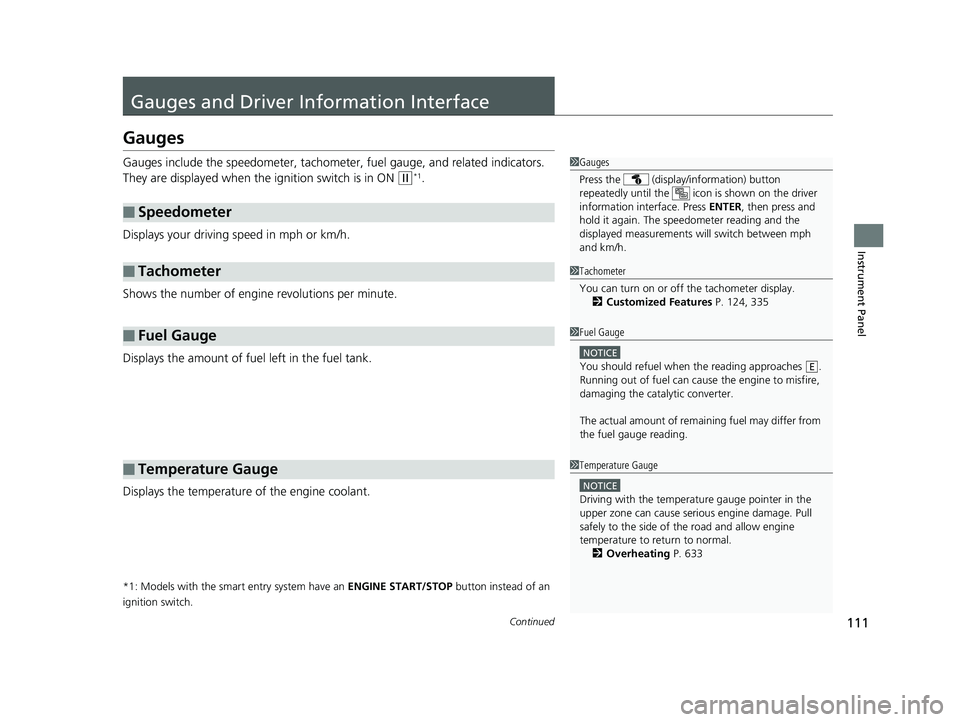
111Continued
Instrument Panel
Gauges and Driver Information Interface
Gauges
Gauges include the speedometer, tachometer, fuel gauge, and related indicators.
They are displayed when the ignition switch is in ON
(w*1.
Displays your driving speed in mph or km/h.
Shows the number of engine revolutions per minute.
Displays the amount of fuel left in the fuel tank.
Displays the temperature of the engine coolant.
*1: Models with the smart entry system have an ENGINE START/STOP button instead of an
ignition switch.
■Speedometer
■Tachometer
■Fuel Gauge
■Temperature Gauge
1 Gauges
Press the (display /information) button
repeatedly until the ic on is shown on the driver
information interface. Press ENTER , then press and
hold it again. The spee dometer reading and the
displayed measurements wi ll switch between mph
and km/h.
1 Tachometer
You can turn on or off the tachometer display.
2 Customized Features P. 124, 335
1Fuel Gauge
NOTICE
You should refuel when the reading approaches .
Running out of fuel can cause the engine to misfire,
damaging the cata lytic converter.
The actual amount of remain ing fuel may differ from
the fuel gauge reading.E
1 Temperature Gauge
NOTICE
Driving with the temperat ure gauge pointer in the
upper zone can cause serious engine damage. Pull
safely to the side of th e road and allow engine
temperature to return to normal.
2 Overheating P. 633
19 CIVIC 2D HCM (KA KL KC)-31TBG6300.book 111 ページ 2018年9月4日 火 曜日 午後1時38分
Page 584 of 675
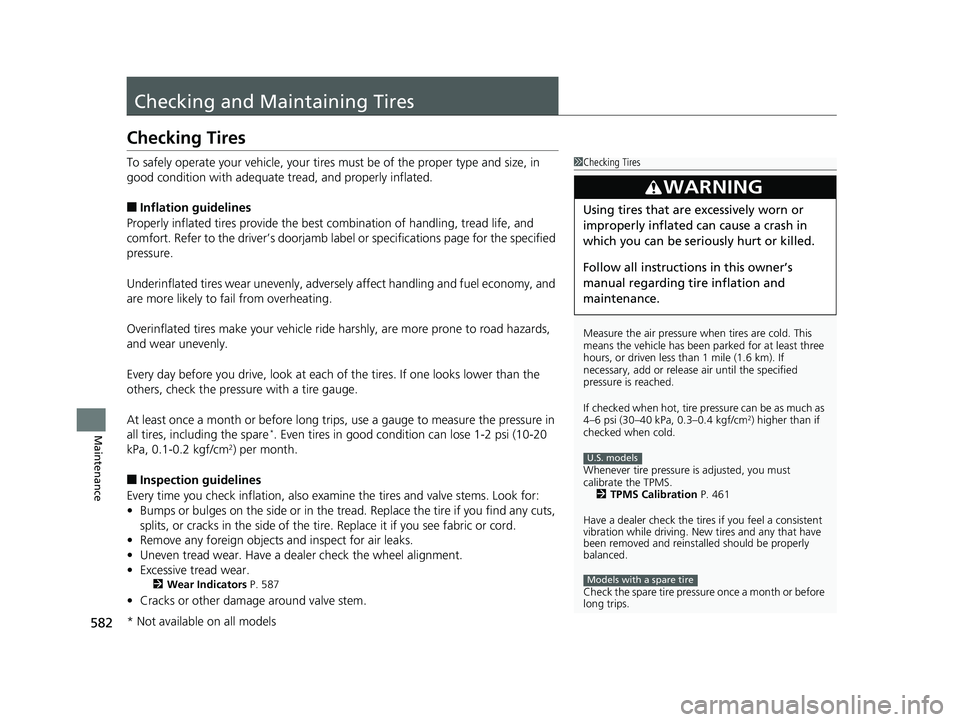
582
Maintenance
Checking and Maintaining Tires
Checking Tires
To safely operate your vehicle, your tires must be of the proper type and size, in
good condition with adequate tread, and properly inflated.
■Inflation guidelines
Properly inflated tires provide the best combination of handling, tread life, and
comfort. Refer to the driver’s doorjamb labe l or specifications page for the specified
pressure.
Underinflated tires wear unevenly, adversely affect handling and fuel economy, and
are more likely to fail from overheating.
Overinflated tires make your vehicle ride harshly, are more prone to road hazards,
and wear unevenly.
Every day before you drive, look at each of the tires. If one looks lower than the
others, check the pressure with a tire gauge.
At least once a month or before long trips, use a gauge to measure the pressure in
all tires, including the spare
*. Even tires in good condition can lose 1-2 psi (10-20
kPa, 0.1-0.2 kgf/cm2) per month.
■Inspection guidelines
Every time you check inflation, also examine the tires and valve stems. Look for:
• Bumps or bulges on the side or in the tread . Replace the tire if you find any cuts,
splits, or cracks in the si de of the tire. Replace it if you see fabric or cord.
• Remove any foreign objects and inspect for air leaks.
• Uneven tread wear. Have a deal er check the wheel alignment.
• Excessive tread wear.
2 Wear Indicators P. 587
•Cracks or other damage around valve stem.
1Checking Tires
Measure the air pressure when tires are cold. This
means the vehicle has been parked for at least three
hours, or driven less than 1 mile (1.6 km). If
necessary, add or releas e air until the specified
pressure is reached.
If checked when hot, tire pressure can be as much as
4–6 psi (30–40 kPa, 0.3–0.4 kgf/cm
2) higher than if
checked when cold.
Whenever tire pressure is adjusted, you must
calibrate the TPMS. 2 TPMS Calibration P. 461
Have a dealer check the tires if you feel a consistent
vibration while driving. Ne w tires and any that have
been removed and reinst alled should be properly
balanced.
Check the spare tire pressu re once a month or before
long trips.
3WARNING
Using tires that are excessively worn or
improperly inflated can cause a crash in
which you can be seriously hurt or killed.
Follow all instruction s in this owner’s
manual regarding ti re inflation and
maintenance.
U.S. models
Models with a spare tire
* Not available on all models
19 CIVIC 2D HCM (KA KL KC)-31TBG6300.book 582 ページ 2018年9月4日 火 曜日 午後1時38分
Page 607 of 675
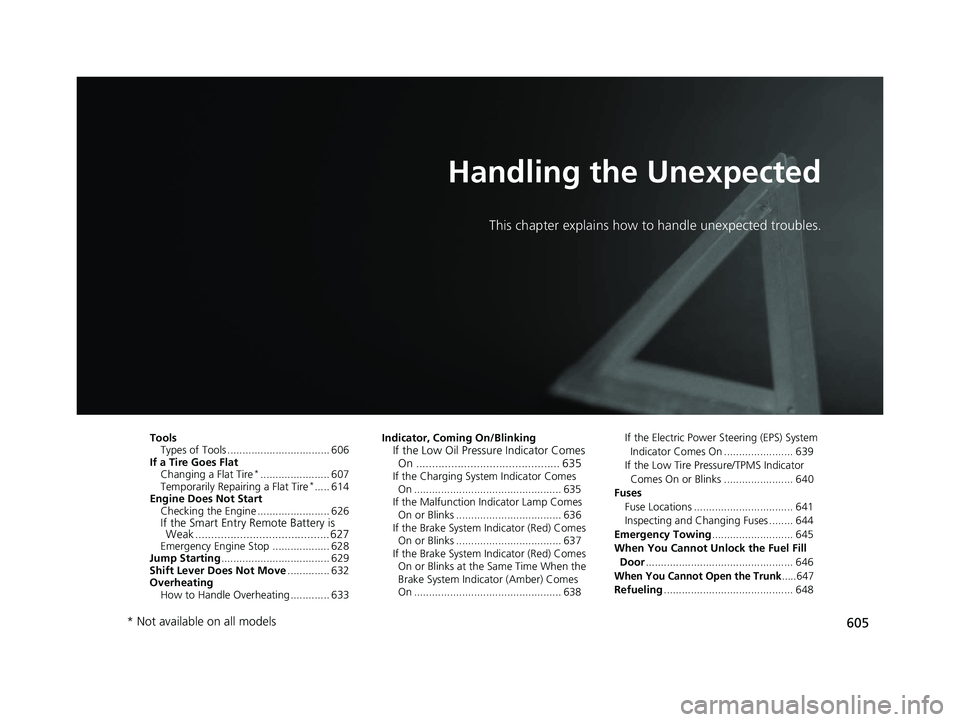
605
Handling the Unexpected
This chapter explains how to handle unexpected troubles.
ToolsTypes of Tools .................................. 606
If a Tire Goes Flat Changing a Flat Tire
*....................... 607
Temporarily Repair ing a Flat Tire*..... 614
Engine Does Not Start Checking the Engine ........................ 626
If the Smart Entry Remote Battery is Weak .......................................... 627
Emergency Engine Stop ................... 628
Jump Starting .................................... 629
Shift Lever Does Not Move .............. 632
Overheating How to Handle Overheating ............. 633 Indicator, Coming On/Blinking
If the Low Oil Pressure Indicator Comes
On ............................................. 635
If the Charging System Indicator Comes
On ................................................. 635
If the Malfunction Indicator Lamp Comes
On or Blinks ................................... 636
If the Brake System Indicator (Red) Comes On or Blinks ................................... 637
If the Brake System Indicator (Red) Comes On or Blinks at the Same Time When the
Brake System Indicator (Amber) Comes
On ................................................. 638 If the Electric Power Steering (EPS) System
Indicator Comes On ....................... 639
If the Low Tire Pressure/TPMS Indicator Comes On or Blinks ....................... 640
Fuses Fuse Locations ................................. 641
Inspecting and Changing Fuses ........ 644
Emergency Towing ........................... 645
When You Cannot Unlock the Fuel Fill Door ................................................. 646
When You Cannot Open the Trunk.....647
Refueling ........................................... 648
* Not available on all models
19 CIVIC 2D HCM (KA KL KC)-31TBG6300.book 605 ページ 2018年9月4日 火 曜日 午後1時38分
Page 635 of 675
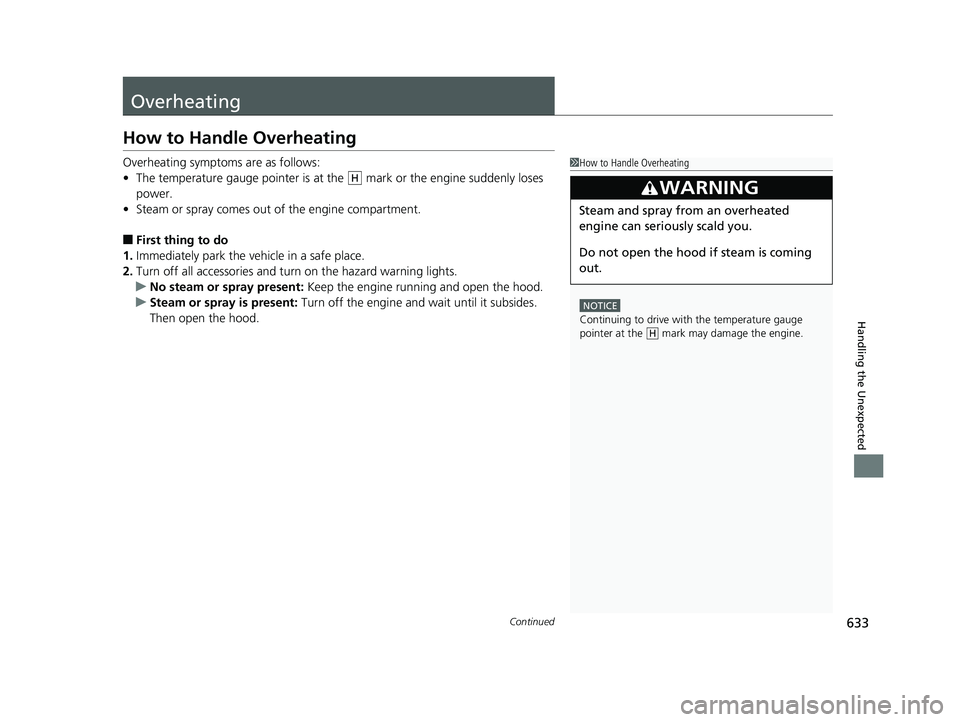
633Continued
Handling the Unexpected
Overheating
How to Handle Overheating
Overheating symptoms are as follows:
•The temperature gauge pointer is at th e mark or the engine suddenly loses
power.
• Steam or spray comes out of the engine compartment.
■First thing to do
1. Immediately park the vehicle in a safe place.
2. Turn off all accessories and turn on the hazard warning lights.
u No steam or spray present: Keep the engine running and open the hood.
u Steam or spray is present: Turn off the engine and wait until it subsides.
Then open the hood.
1 How to Handle Overheating
NOTICE
Continuing to drive with the temperature gauge
pointer at the mark may damage the engine.
3WARNING
Steam and spray from an overheated
engine can seriously scald you.
Do not open the hood if steam is coming
out.
H
H
19 CIVIC 2D HCM (KA KL KC)-31TBG6300.book 633 ページ 2018年9月4日 火 曜日 午後1時38分
Page 636 of 675
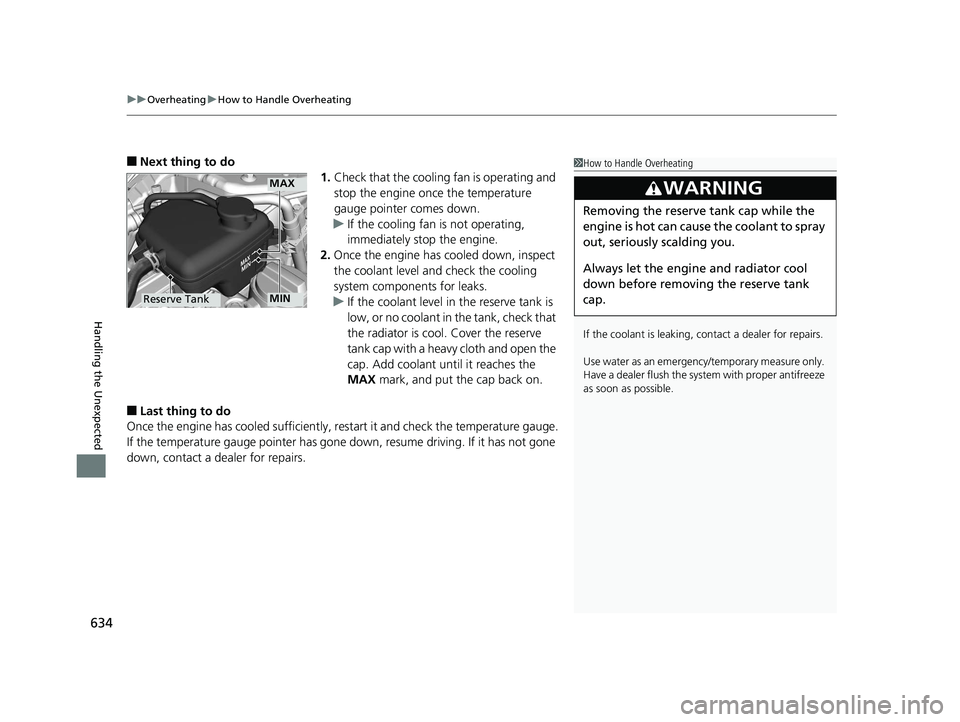
uuOverheating uHow to Handle Overheating
634
Handling the Unexpected
■Next thing to do
1.Check that the cooling fan is operating and
stop the engine once the temperature
gauge pointer comes down.
u If the cooling fan is not operating,
immediately stop the engine.
2. Once the engine has cooled down, inspect
the coolant level an d check the cooling
system components for leaks.
u If the coolant level in the reserve tank is
low, or no coolant in the tank, check that
the radiator is cool. Cover the reserve
tank cap with a heavy cloth and open the
cap. Add coolant until it reaches the
MAX mark, and put the cap back on.
■Last thing to do
Once the engine has cooled sufficiently, restart it and check the temperature gauge.
If the temperature gauge pointer has gone do wn, resume driving. If it has not gone
down, contact a dealer for repairs.
1 How to Handle Overheating
If the coolant is leaking, contact a dealer for repairs.
Use water as an emergency/temporary measure only.
Have a dealer flush the system with proper antifreeze
as soon as possible.
3WARNING
Removing the reserve tank cap while the
engine is hot can cause the coolant to spray
out, seriously scalding you.
Always let the engine and radiator cool
down before removing the reserve tank
cap.
MAX
Reserve TankMIN
19 CIVIC 2D HCM (KA KL KC)-31TBG6300.book 634 ページ 2018年9月4日 火 曜日 午後1時38分